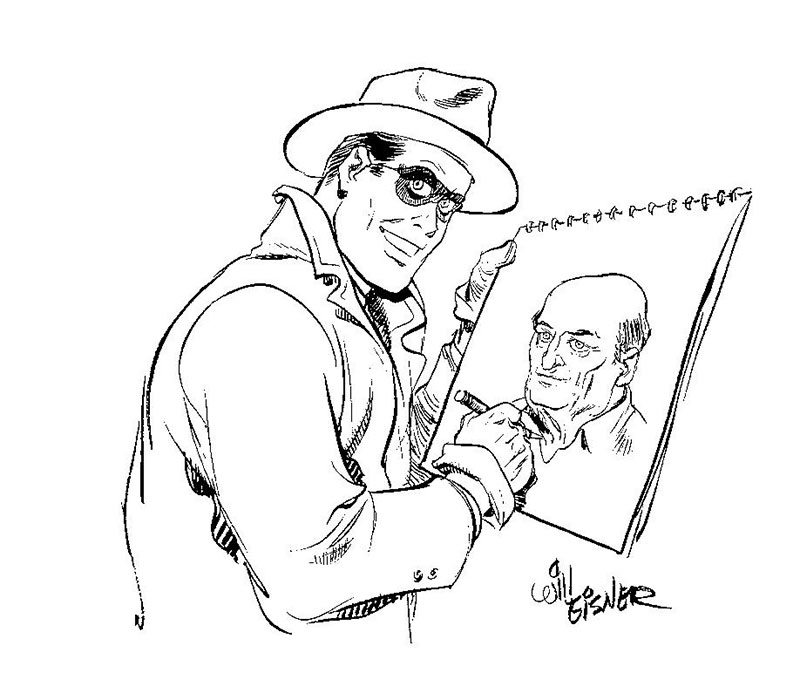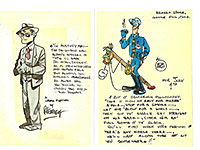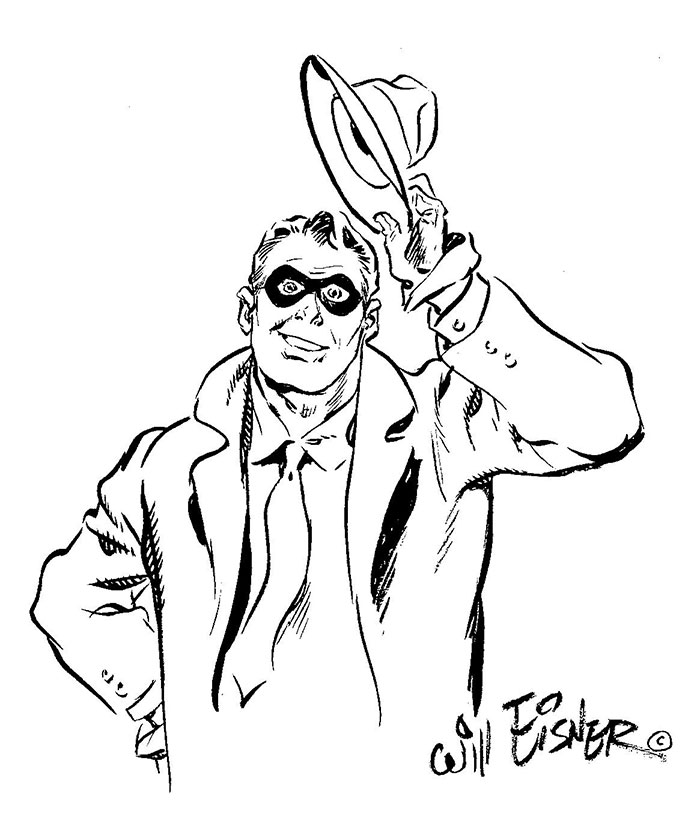OUR LAST
SIGHT OF EISNER’S SPIRIT
Another in
our series commemorating the 100th anniversary of Will Eisner’s
birth.
DOWN THE SCROLL
a bit is the last story Will Eisner would do about the comic book character
that made him famous. It was a story he never intended to do.
“Will
Eisner did not want to do this story,” said Diana Schutz, who was
his editor at Dark Horse, which published the story.
“Really,”
she continued. “I caught him in a moment of weakness and then wouldn’t let him
forget it. I am, as Will once called me, a ‘demon editor.’”
At
the time Eisner produced the accompanying story, he had just finished The
Plot: The Secret Story of the Protocols of the Elders of Zion, which would
be published in 2005. It was a polemic, he told me—a book that made an
argument. The argument in The Plot was that The Protocols of the
Elders of Zion was a monstrous lie, an anti-Semitic slur that had somehow
survived despite generations of being thoroughly debunked in country after
country after country.
Eisner
had deployed the graphic novel as a polemic at least once before—in Fagin
the Jew, which had been published in 2003 just before The Plot. In Fagin,
he had undertaken to give Charles Dickens’ Jewish master thief a better
reputation and a plausible biography instead of the flat stereotype that
Dickens deployed in Oliver Twist.
It
was time, Eisner thought, that the graphic novel be put to serious use. And he
doubtless had other serious uses in mind for the art form that he had almost
single-handedly made into a literary enterprise. But he put all that aside to
do a story for Diana Shutz.
At
the time, Shutz’s editorial projects at Dark Horse included comic books
featuring the Escapist and an authorized biography of Eisner, Bob Andelman’s A
Spirited Life. The Escapist was the comic book character invented by
Kavalier and Clay, two fictional comic book creators that Michael Chabon had
invented in his 2000 novel The Amazing Adventures of Kavalie & Clay as
homage to Joe Shuster and Jerry Siegel, the comic book creators that invented
Superman. In 2004, Dark Horse began publishing a comic book series starring the
Escapist.
From
her unique perch as editor of the two Dark Horse projects, Shutz was able to
elbow Eisner into doing a Spirit story.
“Bob
Andelman and Eisner were hoping that Chabon would write an introduction to the
biography,” Shutz said. “And Michael was hoping that Will would write and draw
a story for the Escapist comic book in which the Spirit meets the Escapist. So
I struck a deal, negotiated a little trade. From my perspective as then-editor
of both projects, it was a win-win scenario. 
“Will
used to joke that he could never refuse me anything,” she continued. “But
asking Will to return to a character whom he’d left behind in 1952—in order to,
eventually, pursue stories set in the real world about real people and their
real hopes and dreams, stories that were far more personally meaningful to Will
than the pursuit-and-vengeance standard of most adventure tales—that required
some serious sweet-talking.
“But
once Will agreed to something, he never backed down,” Shutz went on. “He sure
took his time, though, about doing this story—and I knew his heart wasn’t
really in it. Finally, I recommended that he just ditch the usual superhero
conventions altogether and write a story about these two guys, Denny Colt [aka
the Spirit] and Tom Mayflower [aka the Escapist], who actually have a lot in
common, right down to the mask (that Will always hated putting on the Spirit,
by the way).
“The
non-genre approach piqued Will’s interest,” she finished, “—and then he did me
one better, by working that approach into an adventure story, after all! God
bless him, he was so good.”
Here’s
the story—:
THE DAY AFTER
Eisner sent Schutz the finished art for the story, he checked into the hospital
in Lauderdale Lakes, Florida, for quadruple bypass surgery. The operation was
performed on December 22, 2004, and a week-and-a-half later, on January 3,
Eisner died of complications resulting from the surgery, internal bleeding. He
was only 87, and he’d played tennis almost every day until the last few months.
Eisner
was a legend, a giant, a revered figure in the history of comics. Schutz listed
the landmark achievements of his life: comics entrepreneur and creator of the
Spirit, pioneer of creators’ rights (in an era when that was considered a
preposterous notion), creator and promoter of educational comics, graphic
novelist whose first, A Contract with God, was published decades before
the format became so popular, educator and writer of Comics & Sequential
Art, the field’s seminal textbook, and the man after whom our industry
awards are named.
Despite
his fame and deserved reputation, “Will had a knack for always making you feel
special,” said Schutz.
“It
is both fitting and ironic that this Spirit story should be Will’s last work,”
she continued. “Ironic because he’d moved so far beyond the genre conventions
of The Spirit, and while he was proud of the innovations he’d created
all those years ago, he felt his graphic novels were more important, more
literary, more a testament to what comics could—and should—really be.”
And
most of his life had been dedicated to proving what comics could be.
Schultz
finished: “Yet it is absolutely fitting that Will should come full circle and
leave us with this one last Spirit story, a final gift to all his readers and
fans who clamored for half a century for just this. That should make all of us
feel very special.”
My
own regard for Eisner’s achievement began when I was still in high school in
the 1950s, copying the Spirit in my recreational doodling.  And years later when I
was creating a comic strip to sell into syndication, I continued flattering The
Spirit by imitating a couple scenes from one of Eisner’s stories. (To see
how, visit Harv’s Hindsight for July 10, 2012, “Fiddlefoot: A
Comic Strip that Never Was, Almost.”) And years later when I
was creating a comic strip to sell into syndication, I continued flattering The
Spirit by imitating a couple scenes from one of Eisner’s stories. (To see
how, visit Harv’s Hindsight for July 10, 2012, “Fiddlefoot: A
Comic Strip that Never Was, Almost.”)
My
affection for Eisner began at the moment we met and continued through
subsequent encounters, including several interviews during which I came to know
him better and better.
Five
years after he died, his renowned place in the history of the medium secure and
his prominence towering above all others, came the first of two stabs in the
back of his reputation.
On
July 1, 2010, Ken Quattro posted at his thecomicsdetective.blogspot the
transcript of Eisner’s testimony at the first copyright infringement case in
comic book history, and the transcript proved Eisner had lied—both on the stand
at the trial and in recounting the incident in later years.
Quattro
was devastated. “Will Eisner is my hero,” he said. “To me he was a Promethean
figure—creative, farsighted and flat-out brilliant. ... Nothing spoke more to
his integrity than the story of his testimony in the groundbreaking lawsuit, DC
vs Victor Fox.”
Like
Quattro, I was stricken. But I read the transcript—hoping whatever Eisner said
could be interpreted in some way that would exonerate him. No luck.
Victor
Fox had been working at DC Comics and had observed the success of Superman when
the character had debuted in Action Comics, No.1 in the spring of 1938.
The next winter, Fox, “hoping,” as Quattro put it, “to catch the coattails” of
Superman’s success, launched his own comics publishing company, and he hired
the Eisner-Iger shop to produce the lead feature, which, as Fox directed, was
an out-and-out imitation of the Man of Steel called Wonder Man.
DC
sued, claiming copyright infringement. And as the case approached trial, Fox
asked Eisner, who drew Wonder Man according to Fox’s specifications, and Jerry
Iger, Eisner’s partner, to testify that they’d created Wonder Man without
knowing about Superman.
In
telling the story in his later years, Eisner said he couldn’t do what Fox
wanted.
“It’s
not true,” he told his biographer Andelman. “Victor described the character
exactly the way he wanted him in a handwritten memo. Obviously, a complete
imitation of Superman.”
“Eisner
agonized about what he’d say at the trial,” wrote Andelman. At the time, Eisner
was only 22 years old and on the cusp of creating a career in comics. If he
told the truth, what would become of his career?
“Finally,”
said Andelman, “he decided that he couldn’t commit perjury and, when called to
the witness stand, he testified that Fox literally instructed Eisner and Iger
to copy Superman.”
The
only noticeable consequence was the Fox didn’t pay the Eisner-Iger shop for the
work it had done.
But
the transcript shows that Eisner did as Fox had demanded. That he hadn’t told
the truth. That he’d lied to protect Fox. And then when relating the story to
Andelman, he’d lied again.
It
was a sad day for the legions of Eisner fans. But we all found reasons to
excuse Eisner. We had to.
And
then last year came another blow, this time to Eisner’s reputation as the
inventor of the graphic novel.
Eisner’s
claim to have created the graphic novel with the 1978 publication of his A
Contract With God was always on shaky ground. First, the book is not a
novel: it’s a collection of short stories. And Eisner didn’t use the term
“graphic novel” in print until the second printing of the book. At one time, he
claimed he’d picked the term out of the air when pitching the book to
publishers.
The
term was pretty certainly coined by Richard Kyle in 1964. Some claim
that George Metzger produced the first graphic novel in 1976 with Beyond
Time and Again, which called itself a graphic novel on the title page.
And
there are earlier claimants. According to Paul Levitz, Harvey Kurtzman’s
Jungle Book in 1959 was “the first all-original comics in book format and a
recognizable prototype of the current graphic novel.” Or was the prototype It
Rhymes with Lust, Arnold Drake and Leslie Waller’s “picture
novel” deliciously rendered by Matt Baker and published in 1950. Or was
it 1968's His Name Is ... Savage, a magazine-sized spy thriller by Gil
Kane and Archie Goodwin that Eisner had seen and lamented its
collapse after only one issue.
At
first, when people said Eisner’s Contract was the first graphic novel,
he went along with it. As these other candidates surfaced, though, he backed
away from the claim, saying, in effect, that the term had been “in the air” at
the time, and he’d merely appropriated it without claiming to have invented
either the form or the term.
But
then last spring, in the inaugural issue of Inks, the journal of the
Comics Studies Society, an article by Andrew J. Kunka shows that Eisner was
aware of the term “graphic novel” and the evolution of the form as early as
August 1974. That’s when Jack Katz sent Eisner a copy of the first
chapter of what he called his “graphic novel,” The First Kingdom.
Katz
continued to send Eisner chapters of the book as they were published until the
last one, No.24, in 1986. Katz accompanied the books with letters, and Eisner
responded, effectively creating a 12-year correspondence in which the two
discussed and applauded the emergence of this adult-oriented form of the comics
medium.
Katz
asked Eisner to write a foreword for the series, which appears in No.23, the
penultimate issue. In it, Eisner acknowledges that Katz “carved out a position
for the graphic novel concept and helped establish a category for work produced
with literary intent.”
Kunka
also speculates that it’s also possible that Eisner saw Kyle’s column in Fantasy
Illustrated No.6 (Summer/Fall 1966) in which Kyle reviews the first issue
of Harvey’s Spirit reprints, using the terms “graphic short story” and
“graphic novel” as part of his discussion.
Still,
as I have said many times, even if Eisner didn’t invent the form or the term,
he explored its potential with great dedication and skill, perfecting the form,
and those who followed afterwards expanded the form, extending its reach,
exploring its potential—in the spirit of Will Eisner.
In
any case, Eisner’s reputation has now been sullied by two circumstances that
contradict what he had said. For those of us who have a high regard for
Eisner—both as an artist and as a man—there must be some plausible explanation
for these contradictions that leaves Eisner’s standing intact, perhaps not
inviolate but still admirable.
Here’s
mine:
Don’t
go to storytellers for factual truth. Eisner was, above all else, a
storyteller. A champion storyteller. Storytellers tell stories, and most of the
stories are made-up. Fictions. Lies. Storytellers are adept at lying. We don’t
go to storytellers for factual truth. We go to storytellers for stories, for
fictions that reveal other kinds of truth, the metaphysical kinds.
Eisner’s
story about his testimony at the DC vs Fox trial is about youthful courage in
the face of economic pressure. We all hope we’d do the same as the Eisner in
this story did.
Eisner’s
story about inventing the graphic novel form and the term denoting it is about
creative inspiration and commercial acumen, coining a term that had greater
appeal for adult readers than the much-maligned “comic book.” We all hope for
inspiration to strike us and make us rich and famous.
His
stories are inspirational. Like all good stories.
What
more can we ask of storytellers?
Just
a little more—:
At
the 1999 San Diego Comic-Con, Eisner was scheduled to appear on a panel with
Chuck Cuidera, who had just lately started coming to comic cons. A few months
before this Comic-Con, Cuidera had been interviewed about his career in comic
books, including his work with Eisner at Quality Comics—specifically, his
connection with the Blackhawks. Eisner is always credited with creating the
Blackhawks, and Cuidera, coming suddenly out of the woodwork, claimed he, not
Eisner, had created the famous team of aviating-troubleshooters.
Their
joint appearance on the same panel promised fireworks and unpleasantness.
The
panel was chaired by Mark Evanier, who, as I understand it, arranged a meeting
between Eisner and Cuidera before the panel convened.
During
the presentation, fairly early on, Evanier asked Cuidera what Eisner had
assigned him to do.
“Well,”
Cuidera joked, “—I did more of The Spirit than I did of Blackhawk!” (laughter)
Then
Eisner chimed in:
“Absolutely.
I'd like to say something, Mark, because this is heading into that. I've been
wanting to say this for a long time, because I've done conventions a lot, and
there's been a lot of talk about who invented what. It's not important who
created it. It's the guy who kept it going, and made something out if it that's
more important. Whether or not Chuck Cuidera created or thought of Blackhawk to begin with is unimportant. The fact that Chuck Cuidera made Blackhawk what it was is the important thing, and therefore, he should get the credit.
It
was the neatest piece of diplomacy I've ever witnessed. And Eisner’s remarks
have the additional virtue of being factually accurate. Eisner’s point was that
Cuidera developed the Blackhawk concept and made the creation famous and
popular.
Eisner
gave Cuidera the lion's share of credit but Eisner never denied
or confirmed Chuck's contention; nor did he, Eisner, ever say, "Chuck's
wrong: I created the Blackhawks." He dodged the bullet but gave Cuidera an
appropriate share of credit —and his dignity.
That’s
the Will Eisner I remember. 
Return to Harv's Hindsights |